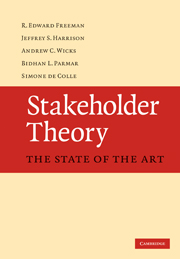Book contents
- Frontmatter
- Contents
- List of figures
- List of tables
- Acknowledgements
- Preface
- Part I The genesis of stakeholder theory
- Part II Stakeholder theory and the traditional disciplines of business
- Part III Stakeholder theory, ethics, and corporate social responsibility
- Part IV Stakeholder theory: some future possibilities
- 9 Stakeholder theory and capitalism
- 10 Questions on the horizon
- Bibliography
- Index
9 - Stakeholder theory and capitalism
from Part IV - Stakeholder theory: some future possibilities
Published online by Cambridge University Press: 05 June 2012
- Frontmatter
- Contents
- List of figures
- List of tables
- Acknowledgements
- Preface
- Part I The genesis of stakeholder theory
- Part II Stakeholder theory and the traditional disciplines of business
- Part III Stakeholder theory, ethics, and corporate social responsibility
- Part IV Stakeholder theory: some future possibilities
- 9 Stakeholder theory and capitalism
- 10 Questions on the horizon
- Bibliography
- Index
Summary
We live in the age of markets. While they have been around for thousands of years, we are just beginning to understand their power for organizing society and creating value. In the last two hundred years markets have unleashed a tremendous amount of innovation and progress in the West. The industrial revolution, the rise of consumerism, and the dawn of the global marketplace have each in their own way made life better for millions of people. Many of us now know comforts, skills, and technologies that our ancestors could only dream of.
Alongside these great strides forward are a set of deeply troubling issues. Capitalism, understood in the sense of “how markets work,” has also notoriously increased the divide between rich and poor, both within and across nations. We have become blind to some of the consequences of our actions that are harmful to others, such as environmental degradation, dominance of less privileged groups, and the inequitable distribution of opportunities. The seeds from these deeply troubling issues are beginning to germinate. Global warming, global financial crises, and global terrorism threaten to destabilize our world. It is more imperative than ever to study carefully and understand the power of markets and capitalism, and begin the construction of a new narrative about how capitalism can be a force for good in the world.
- Type
- Chapter
- Information
- Stakeholder TheoryThe State of the Art, pp. 267 - 285Publisher: Cambridge University PressPrint publication year: 2010
- 1
- Cited by



